Fermilab's superconducting cavity program moves forward

Third harmonic accelerating module team members Tug Arkan, Chuck Grimm and Jeff Wittenkeller stand in front of the completed, packed and ready to ship 3.9 GHz cryomodule.
Superconducting cavity development at Fermilab recently reached a major milestone.
Fermilab scientists and engineers shipped their first successfully completed and tested 3.9 GHz superconducting module to DESY on Friday, April 24.
The module, which consisted of four superconducting cavities and associated infrastructure arrived safely on Tuesday, April 28. It will become part of the German laboratory's FLASH free-electron laser.
Fermilab scientists Helen Edwards and Elvin Harms, leaders of the effort at Fermilab, and TD engineer Chuck Grimm, witnessed the module's arrival and carried out initial checkout. During the next few weeks, other Fermilab scientists, engineers and technicians will be at DESY to check the cavity's systems, alignment and instrumentation before cooling down the module for testing this fall at DESY's Cryomodule Test Bed. Installation in FLASH is expected in early 2010.
"By completing this cavity successfully, Fermilab was able to demonstrate that it can be a key player in developing SRF cavities," said Elvin Harms, an Accelerator Division engineering physicist.
The successful completion and test also marks a milestone for the International Linear Collider, a proposed electron-positron collider that could help to unlock the universe's deepest mysteries. The proposed ILC will comprise 16,000 superconducting accelerator cavities within vessels at near zero temperatures. The cavities used in the ILC would operate at 1.3 GHz, a different frequency than the 3.9 GHz cavities. However, Fermilab scientists found the experience assembling superconducting cavities valuable.
"This milestone demonstrates Fermilab's capability to produce superconducting RF cavities, which are the heart of the ILC," said Andy Hocker, associate scientist in TD.
Scientists from Fermilab, Argonne National Laboratory, and Jefferson National Laboratory carried out precise simulations for the 3.9 GHz cavities. The cavities were horizontally and vertically tested at Fermilab and then assembled into a cavity string at the MP9 Cryomodule Assembly Facility. The final assembly into a cryostat took place at the Industrial Center Building.
"We can all learn from each other, especially in developing new technologies," Harms said.
Harms hailed the successful test as a major step forward. "Fermilab is carving its niche," Harms said. "DESY has acknowledged us as world leaders in building 3.9 GHz systems."
-- Andre Sulluchuco
|